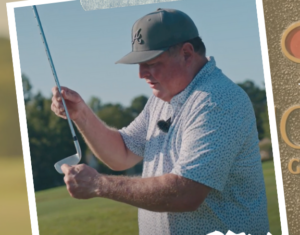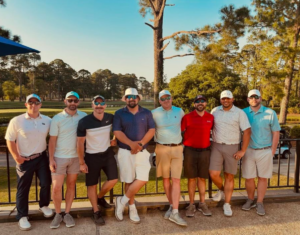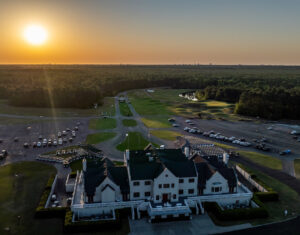As Seen on CBS Sports Network: “The Charlie Rymer Golf Show” Season 1, Episode 15 with “The Beast”
It’s time to grip it and rip it with three-time World Long Drive Championship winner Sean “The Beast” Fister as he’s “Ridin’ with Rymer” on this episode of “The Charlie Rymer Golf Show,” as seen on CBS Sports Network.
Sean and Charlie play Jack Nicklaus’ signature course at Long Bay Golf Club as “The Beast” shares his thoughts on how he got his nickname (hint: it came from a sport other than golf!) and offers some tips on how anyone can gain length off the tee. He’s then off to Heritage Club in Pawleys Island to continue the game improvement theme with his latest segment of “Charlie’s Golf Tips.” You’ll work up an appetite in the process as you check out Charlie’s latest cooking segment, where he’s showing off how to create the perfect Boston Butt for his famous barbecue!
“The Charlie Rymer Golf Show” has aired on CBS Sports Network, the 24-hour home of CBS Sports that is available through all major cable, satellite and telco distributors as well as via OTT streaming service providers YouTube TV, fuboTV, DirecTV and Hulu.
Transcript
Speaker 1:
The Charlie Rymer Golf Show. Starring, Charlie Rymer. Hey, okay, let’s pick up the tempo.
Charlie Rymer:
Charlie Rymer here and welcome to my new show, where we do things my way. As a former golf pro and media personality, I know golf. But this isn’t going to be your grandfather’s golf show. I’m bringing you conversations with celebs and golf greats. Getting off the course and out on the water and even getting into some good eats. This is The Charlie Rymer Golf Show. Keep it in the fairway folks. I’m in Myrtle Beach at Long Bay Club. And today I’m with a long hitter and they call him The Beast. I’m Charlie Rymer and this is Ridin with Rymer.
Sean Fister:
Good grief Charlie, what are you doing?
Charlie Rymer:
When you’re teeing it up with a guy called The Beast, Sean “The Beast” Fister, that’s a three time world long drive champ, it’s a little intimidating. I’m trying to get pumped up.
Sean Fister:
You don’t have to swing that hard. You got to hit it solid. If you don’t hit it solid, you’re not going out and drive anybody.
Charlie Rymer:
You going to help me with my driving a little today?
Sean Fister:
If you help me with my putting.
Charlie Rymer:
Deal.
Sean Fister:
All right.
Charlie Rymer:
Come on. Let’s load them up.
Sean Fister:
Big time Charlie and I’m looking forward to this.
Charlie Rymer:
The Beast. Okay. So I think best ever long drive nickname, you got it, The Beast.
Sean Fister:
I got mine before I even started golf. I got mine from playing softball.
Charlie Rymer:
No way.
Sean Fister:
Yeah.
Charlie Rymer:
And it just worked beautifully for a long drive. So Sean, when was the first time you hit a golf ball and you knew, I’m pretty long at this hitting a golf ball thing.
Sean Fister:
To be honest with you, I didn’t start playing golf till after college. I mean, I was 24. I had an old Spalding plastic driver with a regular flex shaft and I got ahold of one of them and flew it on this 345 yard par four. That was the first day I ever played. Of course, I was shooting a million.
Charlie Rymer:
Yeah.
Sean Fister:
I couldn’t play. But everybody was saying out, “Can you believe how far he hit it on this hole, that hole.” And by the end of that summer, I didn’t really care what I shot because everybody was talking about how far I hit it.
Charlie Rymer:
Right. That’s fun part.
Sean Fister:
[crosstalk 00:02:33] swinging hard. Yeah.
Charlie Rymer:
That first World Long Drive Championship, it almost didn’t happen for you, right?
Sean Fister:
Oh no. Yeah. I mean, I had a car accident seven days out and totaled three cars, including mine. I almost withdrew, I think four or five times during the competition because the thing was my sternum would burn when I hit impact and I just gritted it out and I just kept winning these rounds and advancing.
Charlie Rymer:
Never let a World Long Drive champ hit before you do.
Sean Fister:
Nice.
Charlie Rymer:
As an air, long time. Going at it is as hard as you guys go at it. Injuries are something that have to be prominent.
Sean Fister:
For the mid of my career I was 22 years. I’d hit 450 balls a day easy, some days 1000 with just a driver. Anyway, we figured out that I’d swung over 3 million times.
Charlie Rymer:
I don’t think I can pull a driver out of my back a thousand times. All right. We got 160 Island Green. Wind’s helping a little from the right.
Sean Fister:
Oh it looks good. Come on, hang in there.
Charlie Rymer:
I really like the size of this Island Green. Some of them I think are just too small. I mean, clearly it was the right size for me. I hit it. You?
Sean Fister:
Well, I showed that I’m not used to having a target that small.
Charlie Rymer:
2005, your third and final World Long Drive. You were the last person hitting. It was last ball. We were in Mesquite. We were on ESPN. It was cold and you hadn’t hardly hit a ball in the grid and there was no way you had anything left in the tank. Walk me through that drive, that whole situation. How much it meant to you to pick up that third title right there.
Sean Fister:
The last ball, I remember looking over and I saw somebody patting on the shoulder and I read their lips.
Charlie Rymer:
That might have been me because I was standing there. I didn’t think you could do it.
Sean Fister:
They said, “There’s no way.” I saw them say that. And I thought to myself, wow, no way. Huh? I backed up and I had about minute on the clock and I just stood there and closed my eyes. And I imagined that shot that I needed went just like I planned. Boom. Last ball hit that spot and rolled out past 373. And I lost it. That was when I went high fiving and…
Charlie Rymer:
Oh man. There was a great crowd there. I went in there, got the interview and just the joy that I could feel coming from you. Honestly it was the coolest moment I’ve ever had in [inaudible 00:05:26].
Sean Fister:
Well, it was the coolest moment I’ve ever had. Period.
Charlie Rymer:
All right. I’m excited to get some of your thoughts on this whole 18 here at Long Bay. This is a heck of a driving hole, 445. We got water to the right. We got some out of bounds to the left. Not a big area to try and hit into. Driving is not the best part of my game. And I know you’ve had a gazillion questions over the years about driving.
Sean Fister:
Well, I’ll give you a two point thing to think about. One is instead of focusing on turning your left shoulder on the takeaway, everybody gets caught up with how far back that left shoulder is, but they forget about, they leave the right shoulder there. So you’re real tensed and limited. So if you just focus on turning the right shoulder, look what the left shoulder does automatically. Don’t think about the left shoulder. Turn the right. So when you turn the right shoulder full, the next thing you think about is making sure your left ear is on that side of the golf ball when you make impact.
Charlie Rymer:
All right. I got it. Let me see if that works.
Sean Fister:
Smoke. That’s right in the middle of fairway. Look at that.
Charlie Rymer:
Yeah. I like that. You got me thinking some. I make me feel bad. I can’t take it. You stink. I don’t like you anymore.
Sean Fister:
That’s all right. I’m used to hearing that Charlie. You’ll get over it.
Charlie Rymer:
Get in the cart. It’s going to be a long ride to get to that one.
Sean Fister:
This is a great day, Charlie. Thanks for having me out.
Charlie Rymer:
Such a great day. Wait. You got this two feet to win the match.
Sean Fister:
Oh this is to win a match.
Charlie Rymer:
I told you I was going make you putt today.
Sean Fister:
Just a little longer.
Charlie Rymer:
You feel a little heat?
Sean Fister:
This is not my forte, Charlie.
Charlie Rymer:
All right, let’s see what you got. It just ain’t fair. He can hit it 400 yards and he can putt. Sean, I appreciate you coming out and Ridin with Rymer today. Sure was a lot of fun.
Sean Fister:
Yeah. Blast.
Charlie Rymer:
Let’s head over here to the cart. We’ll head in the clubhouse. I’m going to let you buy me something cold to drink. Come on buddy. Heritage Club is one of the premier golf courses in the Myrtle Beach area ranked as one of the 50 best public courses in America by Golf Digest. The Dan Maples design offers a unique landscape covered by the whims of the river stretching over 600 acres and 300 year old oaks, all transformed into a golf community that [inaudible 00:07:59] the finest in the world. The majestic landscape is only trumped by the fantastic golf holes that challenge you along the way. But hey, that’s what Charlie’s golf tips are for. I’m playing the most fun golf courses Myrtle Beach has to offer. And I’m trying to lower your handicap along the way. So pay attention folks. The big timer is going to teach you a thing or two.
Sean Fister:
This is 16th hole here at Heritage Club. Beautiful par four framed by the trees on the right and the left. Look right down the middle of this fairway. Yeah. That’s a pole, green and white stripe. A lot of golf courses do that. That pole is dead center of the fairway, 150 yards from the middle of the grain. Knowing that, especially if it’s a first time you’ve played a golf course can be really, really helpful. Do a little basic math here. So it’s 400 yards from here, that pole is 150. I got 250 yards to get there. Guess what I hit exactly? 250 yards. My three would. So let’s give that a shot. You see how I just threw that down on the tee? That is an absolute no, no.
Sean Fister:
When I was 17 years old, I was playing golf with Jack Nicholas. I did that. He yelled at me for an hour. He said, “Whenever you can, always put a tee under the ball.” He looked at me dead square in the eye and he said, “Air has less resistance and turf.” I’ve got no idea what that means, but I always tee it up. Ain’t that too hard? I think I went like 252, but I can live with that. That’s a perfect nine iron. Now let’s dig into this shot a little bit. This is a big green, whole location is on the front right. If I miss it short or right, I got a real easy up and down. That big bunker that guards the middle of this green, I don’t want anything to do with that. So my goal here is to give myself a 20 foot uphill birdie putt from a little short and a little right. And I want to make sure I don’t go left at all.
Sean Fister:
Here’s how I get rid of that left side of that golf course. I’ve got to make sure that I’m aggressive with my lower body on this golf swing. The only way I can hit it in that bunker is if my lower body slows down and my hands flip over to the left. Little nine iron, I’m going to try and go a little right of that flag. Let’s see what we get. Keep the lower body moving. It’s almost like I’ve done this before. You like that one. Didn’t you? Yeah, I did too. Every now and then I get a flashback. On a serious note short putts like this, a lot of people now are leaving the flagstick in because of the change in the rules a few years back. Early on, you saw PGA Tour players leaving the flag in quite a bit. Now, not so much. I encourage you to take it out, especially on short putts because when this stop is down in that hole, I think there’s less room for the ball to go in there.
Sean Fister:
Hard to hold back talent, folks. Hope you enjoyed that birdie. 17 here at Heritage Club of 425 yard par four. As you can see, it’s got some left to right. And I’ve got just the club for that. Let’s dig into this club a little bit. Most manufacturers have a ton of adjustability in their drivers, not only with the loft, which impacts up and down a spin rate, but with the weight balance in the back of the club. I want you to look at that tungsten plug right there. That weighs over 20 grams and there’s three positions it can be in. I’ve got it out towards the toe. And with this wrench, I can actually move it farther left. And the actual movement of that plug, if I swing the exact same way every time, will impact the flight of this ball more than 40 yards left to right. I’ve got it out towards the toe. What that does is it slows the toe down a little bit because there’s more weight out there that keeps the club face open, promotes a cut, which is exactly what I won’t hear.
Sean Fister:
I’m going to aim just a little inside that far bunker, trust that my equipment is going to let me slide this ball from left to right. Something like that. Oh, I got to get my wrench. You watch any PGA Tour golf at all, you always see players and their caddies working in really super cool yardage books. What are they looking at? Well, they’re generally dealing with two different numbers. They want the number to the flagstick, but they want the carry yardage to get to the front of the green or carry whatever trouble is in front of the green. This is a great example of knowing two numbers and how it’ll help you.
Sean Fister:
When I shoot this flagstick with my laser, I’m getting 135 yards, but all I see is that huge bunker. I know if I hit it in there, I might not ever come out. So I want to know what it is to carry that bunker. I shoot that, and I’ve got 118 yards into the face. So I know if I carry this ball 120 yards, then that bunker’s not in play. My flag’s 135. That’s 45 feet. So most amateurs will look at this shot and they’ll get intimidated by that bunker. But if they do just a little bit of math, it’ll allow them to commit to that shot because they know they can carry 120 yards without any problem. So now I’ve got all that cleared out. I’m going to take dead aim at this flagstick and that bunker right now is no worry at all.
Sean Fister:
Just a little bit of math helps you commit to the shot. It doesn’t take that much longer to do it either. The greens here at Heritage Club have a lot of character to them, a lot of movement. They’re a lot of fun. And the 17th is definitely a great example of that. Now this putt I’ve got here may be 18 feet. There’s a lot going on. And the best way to how this putt’s going to break is change my position. I want it getting about halfway to the hole on the downhill side. I can just see everything better here. In this case, this putt two thirds of it is uphill. The last third goes downhill and down to the right and I can see it all beautifully from this position. Couldn’t necessarily see it if I was just behind this golf ball. So I got a good picture. I’m going to leave the flagstick in because remember that last third is downhill. This putt might have a little speed as it’s releasing. All right, I’m looking at maybe a cup on the left. Let’s see what we get.
Charlie Rymer:
On your next trip to Myrtle Beach, make it a priority to play at Heritage Club. Who knows? Maybe you’ll see me there too. I’m here in my hometown, Myrtle Beach, South Carolina. And today I’m going to turn this Boston butt pork shoulder into the most amazing barbecue sandwich you have ever seen. Now this meal is inspired by my former college teammate, David Duval. David always had a perfect game plan and he had the discipline to stick to that game plan. And that’s the two things it takes to make sure that you get a Boston butt cooked up just right in a big green egg. Okay. Here’s how the process starts. I’m going to take some yellow mustard and I’m going to slather this thing up really good. Mostly what this mustard is doing is going to hold the dry rub that I’m about to put on here, close to that meat during the whole smoking and cooking process. And when it’s all done, it’ll have a dark, almost black bark to it.
Charlie Rymer:
I’m going to go ahead and get the bottom side of that. Woo. That’s some good fat right there. I’m going to cook it fat side up so that fat drips down in the meat. And this dry rub, don’t get stingy with it. You can see that mustard just holds it in place, create that great bark. All right, let’s get this thrown on that egg. The egg is ready to go. All right. So I got my fireproof gloves. This thing can get to about 800 degrees. And when you open it up, you got to hold it at about a half inch for just a second. Otherwise, it can burp and you don’t want to be around when this thing burps at 800 degrees. All right. I’m going to put some chips in there. This is hickory wood. It’s been soaking in the water. It’s going to start smoking pretty darn quick.
Charlie Rymer:
Next thing you got to do is put this contraption in there. This is called a plate setter. Otherwise, it would burn at roast up. And then I’m going to throw my drip pan, which just has water in there. And that obviously is going to catch the fat coming off of that roast. But that water’s also going to keep things nice and moist in there. It creates a little bit of steam. I’m using a couple temperature approach here. I’ve got one attached to the grill. That’s just going to give me an idea. Sometimes you got to adjust the air flow for the heat. And now we’re ready to go. We’re going to put this pork shoulder on there. We got a good game plan just like David Duval. I’m going to put one more temperature probe up in this meat, in the fat part right there. And we’re ready to go. I won’t open this big green egg up until that temperature probe gets to be at least 190 degrees. That’s going to be some great barbecue right there, folks.
Charlie Rymer:
It’s time to see how we’ve done. Oh my goodness. Look at that. It’s absolutely perfect. That’s what a pork butt should look like, folks. Right there you see the dark part on the outside. That was a mustard mixed in with that dry rub. Let’s dig into it just a little bit. Oh my goodness. You see that redness right there, that’s a smoke from the hickory. And on the outside, that’s where the mustard mixed with the dry rub. That’s where all the flavor is. I got to have a little bite of that. We’re going to get back to this in a second. But first let me talk to you about this slaw. This is a store bought cold slaw. I take some diced onions, some diced jalapenos, a lot of mustard and the dry rub that I used on the pork, mix it all up, mustard to taste, let it set overnight. And I tell you what, this is what really gets the sandwich going.
Charlie Rymer:
I’ll take a couple of forks here and I’m going to pull this pork apart. I’m thinking my buddy David Duval, he would love to sit down and have this meal with us. And when I start thinking about David’s career, we played college together and he had an amazing college career, came out as rookies together, actually on a PGA Tour. And David got to number one in the world. I know a lot of people who have been number one in the world. But right in the middle of when Tiger was playing his best golf, pretty impressive there. How did David do it? He drove the golf ball so incredibly well. If you hit the ball where he hit it off the tee, you could play the PGA Tour.
Charlie Rymer:
And the other thing he did is mental approach is discipline. Absolutely off the charts. One time I was struggling my game and I asked David, I said, “Listen, I’m a mental midget out there. What do I need to do?” He said, “It’s really easy. You figure out what you can do, what you cannot do and you never try to do what you cannot do.” That’s some wisdom right there. The sauce I’ve got is a South Carolina red. Do just a little right on the top like that because this meat’s got some great flavor. We got to get some slaw on there. Oh yeah. We going to load this plate up with some chips, maybe just a little bit of extra slaw on the side.And that’s how you do it.
Charlie Rymer:
When golfers get the golf bug, it’s an itch that we just can’t stop scratching. We swing the imaginary club in the elevator. We hit putts on the practice green until well after sundown. We dream about ways to get better. Wouldn’t it be great to take that exact same passion into our business and personal lives? That’s it for the Charlie Rymer Golf Show. Keep it in the fairway, folks. They call me big timer. Does that do it for you?
Sean Fister:
I think that’s great. I think it perfectly fits you.
Charlie Rymer:
Yeah, it does.
Sean Fister:
You are big time.
Charlie Rymer:
I’m want to be known as big sexy, but that doesn’t stick.



